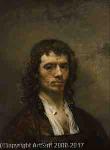Carel Fabritius
Carel Fabritius
Style: Baroque;
Place: Middenbeemster
Born: 1622
Death: 1654
Biography:
In the realm of Dutch Golden Age painting, Carel Fabritius stands out as a prominent figure, known for his innovative use of light and shadow. Born in 1622, this talented artist left an indelible mark on the art world before his untimely death in 1654.
Early Life and Training
Fabritius was a pupil of Rembrandt van Rijn, one of the most renowned artists of the time. Under Rembrandt's guidance, Fabritius honed his skills and developed his unique style, which would eventually become a hallmark of Dutch painting. As a member of the Delft School, Fabritius was part of a group of artists known for their emphasis on realism and attention to detail.
Artistic Style and Contributions
Fabritius's work is characterized by his use of chiaroscuro, an artistic technique that uses strong contrasts of light and dark to create a sense of volume and depth. His paintings often feature domestic scenes, where the interplay of light and shadow creates a sense of warmth and intimacy. Some of his notable works include The Raising of Lazarus, which showcases his mastery of tenebrous effects.
Influences and Legacy
Fabritius's work was influenced by the Italian Caravaggisti style, which emphasized dramatic lighting and intense emotions. His use of atmospheric perspective also added a sense of depth and distance to his compositions. As a result of his innovative techniques, Fabritius's work has been widely admired and emulated by artists such as Johannes Vermeer, who is known for his own mastery of light and shadow.
- Some of Fabritius's notable works can be found in the Rijksmuseum in Amsterdam, which features an extensive collection of Dutch Golden Age paintings.
- The Wikioo.org website provides a comprehensive overview of Fabritius's life and work, including his artistic style and notable contributions to the world of art.
- For more information on the Delft School and its artists, visit the Wikipedia page on Dutch Golden Age painting, which offers a wealth of information on this period in art history.
In conclusion, Carel Fabritius was a talented artist who left an indelible mark on the world of art. His innovative use of light and shadow, combined with his emphasis on realism and attention to detail, make him a prominent figure in the Dutch Golden Age painting tradition. As a painter, Fabritius continues to inspire artists and art lovers alike, and his legacy can be seen in the many museums and art collections that feature his works.
Wikipedia link: Click Here











